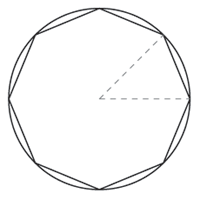Problem Statement
He inscribed and circumscribed regular polygons in/around a circle and calculated their perimeter. These are lower (inscribed polygon) and upper (circumscribed polygon) bounds for the perimeter of the circle, and therefore can be used to calculate lower and upper bounds for Pi. He then found a formula for directly calculating the perimeter of inscribed and circumscribed polygons with 2*n sides only using the values previously calculated for polygons with n sides.
You now have a slightly simpler task, considering only inscribed polygons. You are given an int numSides, the number of sides of a regular polygon that is inscribed in a circle. Return a double, the approximated value for Pi when the perimeter of that polygon is used as an approximation for the perimeter of the circle.
 [Image showing a circle with an 8-sided regular polygon inscribed]
[Image showing a circle with an 8-sided regular polygon inscribed]Definition
| Class: | Archimedes |
| Method: | approximatePi |
| Parameters: | int |
| Returns: | double |
| Method signature: | double approximatePi(int numSides) |
| (be sure your method is public) | |
Notes
If your result is within 1e-9 of the expected result, your solution will be evaluated as correct.
If your result is between (1+1e-9) * expected and (1-1e-9) * expected, it will be evaluated as correct.
Constraints
Examples
| |
Returns: 2.598076211353316 | |
| |
Returns: 3.0614674589207183 | |
| |
Returns: 3.1415926362832276 | |